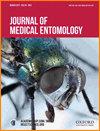为预防南美锥虫病而控制三蠹的范围审查:拉丁美洲和美国现有的和正在开发的工具
IF 2
3区 农林科学
Q1 ENTOMOLOGY
引用次数: 0
摘要
南美锥虫病是一种影响人类和动物健康的传染病,美洲每年有 600-800 万慢性感染者,超过 5 万人死亡。三足虫亚科的食血昆虫(又称接吻虫)传播原生动物寄生虫南美锥虫病(锥虫科:Trypanosomatidae),导致南美锥虫病。尽管恰加斯病对人类健康造成巨大负担,但它是一种被忽视的热带疾病,用于研究和预防的资金不足。鉴于大多数试图保护公众健康的机构都处于资源匮乏的环境中,因此必须考虑所有控制方案,以减少病媒数量和人类接触南美锥虫病的风险,从而确定最适合各种情况的工具。虽然有许多三蠹虫控制方法,但文献中缺乏对所用策略的汇编、对其效率的批判性研究,以及与美洲其他地区相比对美国三蠹虫控制的特别关注。在此,我们对文献进行了回顾,以评估现有和正在开发的三蠹虫控制方法的历史干预策略。对于每种方法,我们都讨论了该领域的进展、未来进一步推进该方法的研究以及局限性。虽然我们发现拟除虫菊酯杀虫剂仍是最常用的三蠹虫和南美锥虫病控制方法,但我们建议,用正在开发的替代控制方法来补充这些技术,将有助于实现减少南美锥虫病的目标。本文章由计算机程序翻译,如有差异,请以英文原文为准。
A scoping review of triatomine control for Chagas disease prevention: current and developing tools in Latin America and the United States
Chagas disease is an infectious disease of human and animal health concern, with 6–8 million chronic human infections and over 50,000 deaths throughout the Americas annually. Hematophagous insects of the subfamily Triatominae, also called kissing bugs, vector the protozoan parasite, Trypanosoma cruzi Chagas (Trypanosomatida: Trypanosomatidae), that causes Chagas disease. Despite the large human health burden, Chagas disease is a neglected tropical disease with inadequate funding for research and preventive practices. Given the resource-poor environment of most agencies trying to protect public health, it is critical to consider all control options for reducing vector populations and the risk of human exposure to T. cruzi to identify the most appropriate tools for each context. While numerous triatomine control methods exist, the literature lacks a compilation of the strategies used, a critical examination of their efficiency, and a particular focus on triatomine control in the United States compared to elsewhere in the Americas. Here, we present a review of the literature to assess historical intervention strategies of existing and developing triatomine control methods. For each method, we discuss progress in the field, future research to further advance the method, and limitations. While we found that pyrethroid insecticide is still the most commonly used method of triatomine and Chagas disease control, we suggest that complementing these techniques with alternative control methods in development will help to achieve Chagas disease reduction goals.
求助全文
通过发布文献求助,成功后即可免费获取论文全文。
去求助
来源期刊
CiteScore
4.60
自引率
14.30%
发文量
207
审稿时长
3-8 weeks
期刊介绍:
Journal of Medical Entomology is published bimonthly in January, March, May, July, September, and November. The journal publishes reports on all phases of medical entomology and medical acarology, including the systematics and biology of insects, acarines, and other arthropods of public health and veterinary significance. In addition to full-length research articles, the journal publishes Reviews, interpretive articles in a Forum section, Short Communications, and Letters to the Editor.

 求助内容:
求助内容: 应助结果提醒方式:
应助结果提醒方式:


